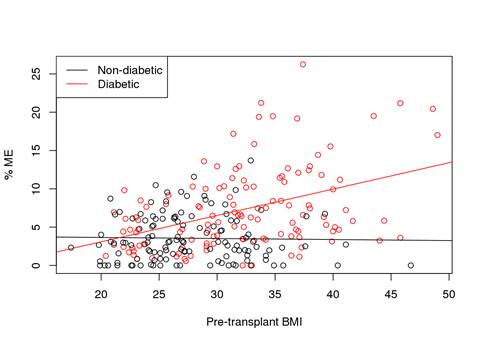Recurrent Diabetic Nephropathy Post Kidney Transplant is Associated with High Risk of Mortality
Mayo Clinic, Rochester, MN
Meeting: 2020 American Transplant Congress
Abstract number: 351
Keywords: Glomerular filtration rate (GFR), Histology, Kidney transplantation
Session Information
Session Name: Kidney Complications: Non-Immune Mediated Late Graft Failure
Session Type: Oral Abstract Session
Date: Saturday, May 30, 2020
Session Time: 3:15pm-4:45pm
 Presentation Time: 3:51pm-4:03pm
Presentation Time: 3:51pm-4:03pm
Location: Virtual
*Purpose: The goal of the study was to determine the incidence of recurrent diabetic kidney disease (DKD) after kidney transplantation (KT) and assess its correlation with patient and graft survival.
*Methods: We performed a retrospective cohort study of kidney transplant (KTx) recipients (recs) who had: 1) T2DM and/or obesity (BMI ≥30 kg/m2) at the time of KT and 2) a surveillance biopsy 5 years post KT. Mesangial expansion (ME) was assessed by 3 methods: 1) Banff (MM score 0-3; 1 mild, 2 moderate, 3 severe) 2) Tervaert classification, used for grading of DKD in native kidney ( MS score 0-4 scale, 1 nonspecific, 2a mild, 2b severe, 3 nodular, 4 glomerulosclerosis); and 3) Computer assisted morphometric analysis (% ME—the sum of all manually traced mesangial matrix expansion areas over the area of all traced glomeruli). Age and sex adjusted models for time to death and graft failure were used to assess the association between ME and outcomes.
*Results: By all scoring methods, histologic evidence of at least moderate ME was highest in recs with both T2DM/Obesity at 5 years. At least moderate ME was seen in 37 patients ( 49.3%) by Banff classification and 9 of these biopsies (12%) showed nodular sclerosis by Tervaert grading.
| No DM BMI<30 (N=85) | No DM BMI>=30 (N=42) | T2DM BMI<30 (N=49) | T2DM BMI>=30 (N=77) | p value | |
| MM>=2 | 9% (11.5) | 8% (19.5) | 2% (4.3) | 37% (49.3) | <0.001 |
| MS>=2b | 4% (4.7) | 5% (11.9) | 2% (4.1) | 20% (26.0) | <0.001 |
| %ME(SD) | 3.8 (3) | 3.0 (3) | 4.6 (3.2) | 8.9 (5.6) | <0.001 |
When ME was scored morphometrically, increased %ME was seen predominantly in T2DM, and the severity positively correlated with increased BMI (figure).
.
At 1 and 5 years, eGFR and proteinuria did not differ between the groups. Mean follow up since tx was 10.8 years. Importantly, recurrent DKD did not correlate with death censored graft loss but rather was highly correlated with mortality: 50% of the recs with MM>2 died subsequent to the 5 year biopsy (p=0.007), while %ME at 5 years had the strongest correlation with mortality (p=0.001).
*Conclusions: Recurrent DKD is common 5 years after KTx in recs with T2DM and obesity at baseline. Ongoing vascular injury in the kidney may reflect a systemic process that contributes to mortality beyond 5 years. Thus, therapy to prevent recurrent DKD (weight loss, glycemic control, etc) may have an impact on post-transplant mortality in this growing, high-risk population.
To cite this abstract in AMA style:
Kukla A, Merzkani M, Park W, Smith B, Turkevi-Nagy S, Zhang P, Benavides X, Alvarez MMorales, Denic A, Bentall A, Kudva Y, D'Costa M, Alexander P, Stegall M. Recurrent Diabetic Nephropathy Post Kidney Transplant is Associated with High Risk of Mortality [abstract]. Am J Transplant. 2020; 20 (suppl 3). https://atcmeetingabstracts.com/abstract/recurrent-diabetic-nephropathy-post-kidney-transplant-is-associated-with-high-risk-of-mortality/. Accessed December 17, 2025.« Back to 2020 American Transplant Congress

